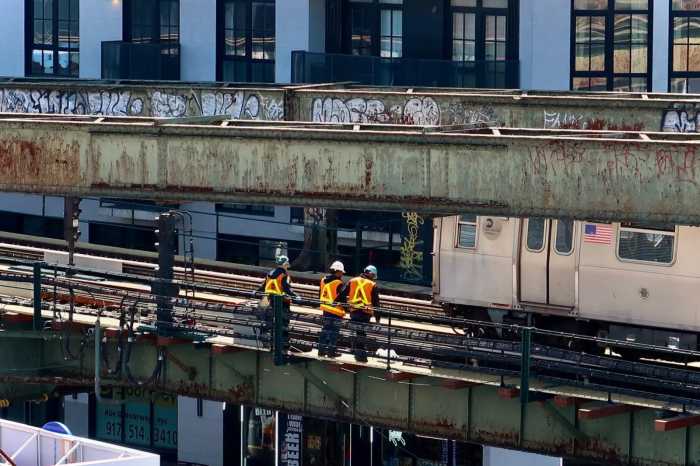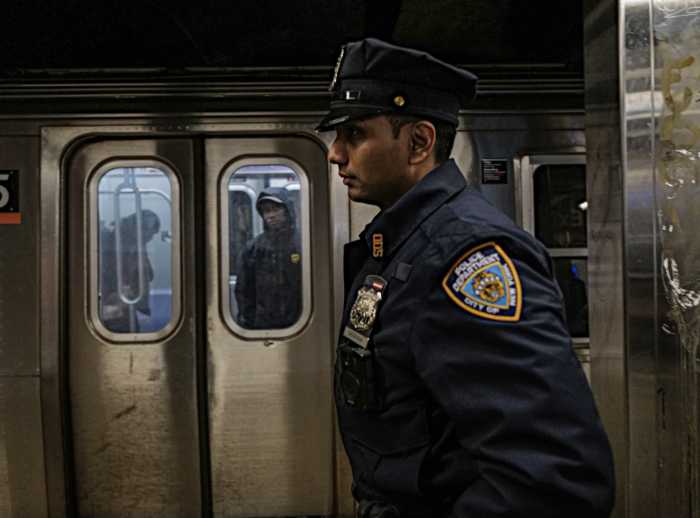Father-and-son developers David and Jed Walentas sat through a nearly
seven-hour City Council subcommittee meeting Tuesday just to endure apparent
failure in an application for rezoning to build a 16-story tower near
the Brooklyn Bridge in DUMBO.
“If we were to take a vote today on the proposal, I would vote no,”
said Queens Councilman Tony Avella, chairman of the committee, suggesting
that the committee would follow his lead.
“I want you to take that back with you, and think about that,”
he told the developers.
Avella later told The Brooklyn Papers that he hopes the Walentases will
revise their latest proposal for 38 Water St. at Dock Street in DUMBO,
and re-submit their plans before the subcommittee votes on Oct. 5.
The Walentases, through their Two Trees Management company, seek to build
an apartment and commercial complex that would rise next to the Brooklyn
Bridge approach ramp. The original plan made rocky progress — both
Community Board 2 and Borough President Marty Markowitz issued negative
declarations as part of the city’s Uniform Land Use Review Procedure
(ULURP).
After that, Two Trees scaled back the plan, shaving the building height
down to eight stories along a stretch of the property closest to the bridge.
That modified plan earned the support of the City Planning Commission.
It is now up to the City Council to decide the project’s fate.
The biggest uproar continues to be over the blocked views of the bridge
from DUMBO and the consequent obstructed views of Brooklyn from the bridge.
The Walentases have been criticized for having blinders to the context
of the neighborhood.
It isn’t the first time such charges have been leveled at David Walentas,
who largely created the gentrified DUMBO neighborhood that exists today.
In 1999, his attempts to develop a massive park-apartment building-hotel-outdoor
mall complex in Empire-Fulton Ferry State Park were rejected. David Walentas
said his plans, which predated formal plans for Brooklyn Bridge Park,
created an “intimate” relationship with the Manhattan skyline,
critics from the adjacent neighborhoods of Brooklyn Heights, DUMBO and
Fulton Ferry argued they were “isolationist” and “insensitive”
to the surrounding community.
Most contentious was the centerpiece of the plan, a hotel built out onto
the East River at the park’s north end, which would have virtually
obliterated views of another famous, if less aesthetically pleasing span
— the Manhattan Bridge.
On Tuesday, Avella complimented Two Trees’ amendments to their original
38 Water St. proposal, in which the tallest part of the tower perched
only 70 feet away from the Brooklyn Bridge. The revised plan left it at
88 feet high near the bridge, rising up to 178 feet at a point 134 feet
away from the bridge overpass. An additional 20,000 square feet of residential
housing was lost as a result.
Still, he said, “I’ve been very uncomfortable about blocking
the view of the bridge, [and] from the bridge.”
The revised plan still includes a 327-space, underground parking garage,
8,000 square feet of retail space, an 8,300-square-foot community facility
for a non-profit arts organization and approximately 200 units of housing.
Brooklyn Heights-DUMBO Councilman David Yassky compared the Walentas proposal
to the eyesore of the Verizon building — with its bright-red, lighted
checkmark — on the Manhattan side of the bridge, and cited the Brooklyn
Bridge’s historic importance as his main concern.
“The symbolic importance of the [bridge] cannot be overstated,”
he said, calling it “one of New York’s most recognizable structures.
Indeed, the image of the bridge is recognized throughout the world.”
Several members from area community groups also spoke in opposition to
the plan, but many, in e-mails sent just prior to the meeting, criticized
Yassky’s belated response after he was silent for months prior to
the hearing. His reluctance to speak out led to suspicions of his support
for the Walentas proposal.
“How our elected representative to the City Council could listen
so well to the wishes of one person and not to the strongly expressed
opinions of the very people who elected him to represent the historic
district of Brooklyn Heights and surrounding landmark communities is confounding
to us,” wrote Judy Stanton, executive director of the Brooklyn Heights
Association, in an e-mail sent before Yassky sided with their cause last
week.
At the hearing, when asked about Yassky’s latecomer support, she
grimaced.
“Well, it’s the first step,” she said.
The architecture firm of Beyer, Blinder, Belle, hired by Two Trees for
38 Water St., displayed a model at the hearing depicting the bridge and
neighborhood, and emphasized, using a miniature scale model of the earlier
design and the newest one, the significant changes that had been made.
Lead partner Jack Beyer pointed out, “This building must be seen
and understood and evaluated in the context of the Gair complex,”
the group of DUMBO warehouses that Walentas has converted to residential,
artist and office space.
When Jed Walentas spoke, he appealed to the need for housing in DUMBO,
and more customer traffic for local retailers. He promised the building
would house about 40 affordable units, provided it was accepted into a
city-subsidized program. He cited the City Planning Commission’s
9-1 vote in favor of the zoning changes, and mentioned having taken suggestions
from Yassky, the Landmarks Preservation Commission, City Planning Director
Amanda Burden and her predecessor, Joe Rose.
Then he issued a thinly veiled warning, suggesting that if the application
was denied one option would be to build a 12-story “as-of-right commercial
building” at the site instead.
“It isn’t the right use, but it is an as-of-right alternative,”
Jed Walentas said. He finished by saying, “DUMBO is our life; we
treat it with much care, passion and respect.”
In her testimony, Nancy Webster, president of the DUMBO Neighborhood Association,
first acknowledged that Two Trees “does excellent work in DUMBO,”
before requesting that instead of seeking to emulate the Gair buildings,
they model new developments after the four- to six-story, 18th-century
buildings that line Water Street.
“We care deeply about this issue because we feel the glorious vista
across to the Manhattan Bridge will be lost,” she said, and urged
issuance of a lower, R6A residential zoning instead.
Proponents of the building showed up in equal number to the opposition,
with 15 to 20 testifying from each side.
Many of the testimonials given in favor of the plan came from commercial
and residential tenants of Two Trees buildings, as well as a Two Trees
employee who failed to identify herself as such.
Representatives from arts organizations such as Smack Mellon and the DUMBO
Arts Center, and merchants like Jacques Torres, owner of the famous chocolate
shop in a Walentas building on Water Street — who have at one time
or another received rent reductions or deferrals from Walentas —
testified on his behalf. Representatives from the Real Estate Board of
New York, the Brooklyn Chamber of Commerce and the local chapter of the
American Institute of Architects also spoke on the plan’s behalf.
Louise Lansky, who described herself as “a neighborhood resident”
lives in the area and stated that for her, the neighborhood was still
a danger zone.
“Walking in the evenings in that area is a little sketchy, it’s
a little dark and deserted,” she said. With the addition of upwards
of 200 people, “it would not be as scary in the evening,” she
said.
The next day a reporter noticed her giving tours as part of her job as
a leasing agent for Two Trees in a commercial building at 55 Washington
St., where The Brooklyn Papers offices are located.
Asked why she declined to divulge that she was an employee of Walentas
when she testified, Lansky would only say that she stood by her testimony.























